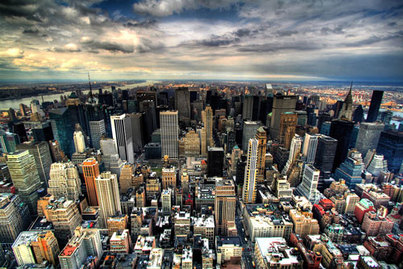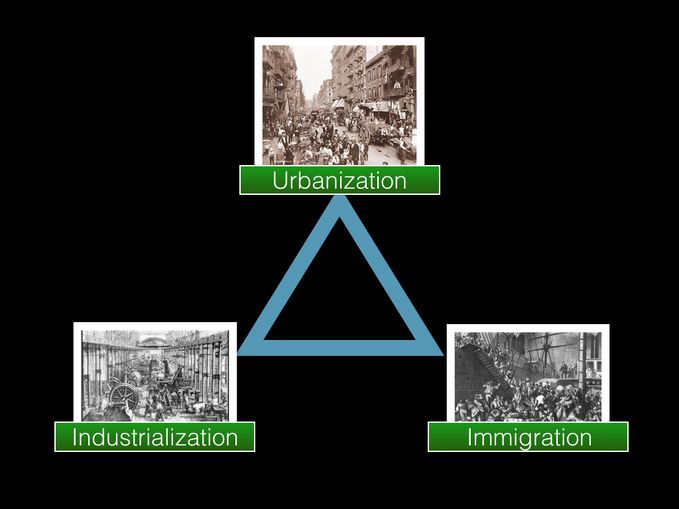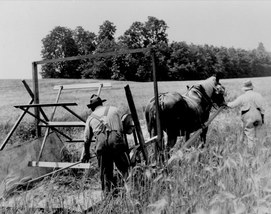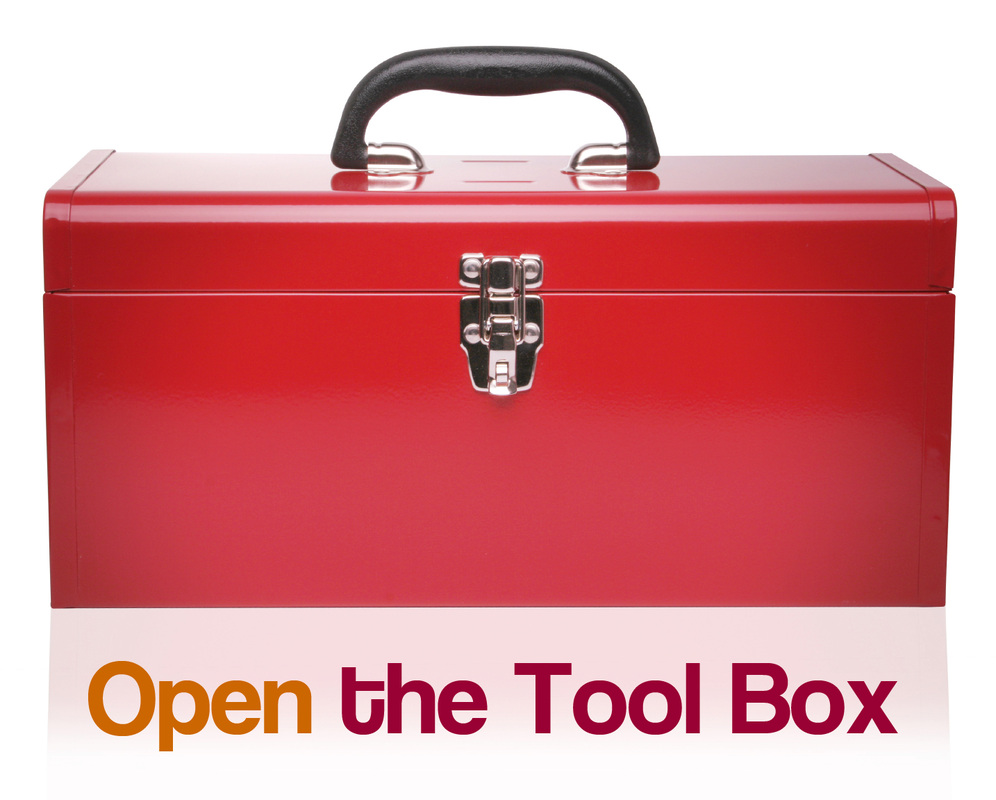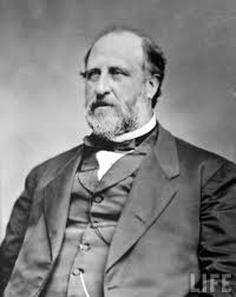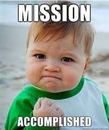Unit 3: The Industrialization Age
TOPIC 2 LESSON:
U.S. URBANIZATION
FOCUS ACTIVITY
Lesson Mission
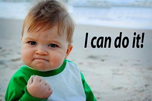
DIRECTIONS: Remember, the Lesson Mission is what you will be able to do after the lesson is over. Begin today's Lesson Chronicles Entry by heading your paper with your name and the date and the Lesson Title. Write down today's essential question. Answering the essential question at the end of the lesson is your Lesson Mission!
Essential Question(s):
What is urbanization? What three things led to U.S. urbanization and how did each thing contribute?
TEACHING ACTIVITY
Slideshow
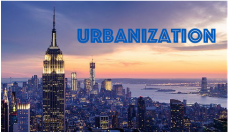
DIRECTIONS:
We will begin today's lesson with a slideshow by David Burns called Urbanization from his Frameworks for America's Past Series. Follow along with me as I go over the slideshow. After the slideshow, write down the three major reasons cities grew rapidly. Click on the urbanization icon to the right to get started.
We will begin today's lesson with a slideshow by David Burns called Urbanization from his Frameworks for America's Past Series. Follow along with me as I go over the slideshow. After the slideshow, write down the three major reasons cities grew rapidly. Click on the urbanization icon to the right to get started.
WHOLE GROUP ACTIVITY
Guided Reading

DIRECTIONS: We are now going to read today's text. Remember, we will stop after each section to identify the main ideas and talk about the vocabulary. Remember to copy down all vocabulary words and definitions into your lesson chronicles.
~ URBANIZATION IN THE U.S. ~
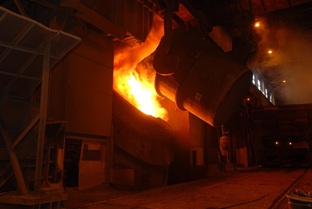 Bessemer Process
Bessemer Process
The Second Industrial Revolution accelerated urbanization. It was the literal “gas pedal” that sent America racing through urbanization! The Second Industrial Revolution moved America from the Age of Iron into the Age of Steel and replaced steam power with electric power. Great factories were built. Mechanization advanced quickly. New transportation systems developed. All of this greatly increased the rate at which urbanization occurred in America.
CAUSES OF URBANIZATION
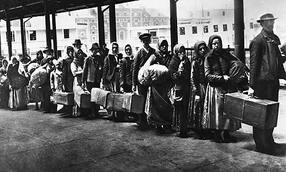 New Immigrants Arriving in America - photo by Lewis Hine
New Immigrants Arriving in America - photo by Lewis Hine
American urbanization occurred for many reasons. Inventions and new technologies of the Industrial Revolution brought exciting new ways of life and activities to cities. Migrants moved from rural areas to cities in search of job opportunities. Industries that specialized in one product tended to locate in city. Immigrants poured in from other countries looking to start a better life in America. Rich industrialists usually had their main corporate offices in big cities so they could be near banks and other businesses and industries. Advancements in infrastructure, transportation, and communication added to urban growth as well.
EFFECTS OF URBANIZATION
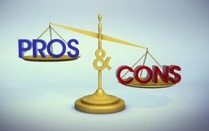 Pros are the good points of an issue. Cons are the bad points of an issue.
Pros are the good points of an issue. Cons are the bad points of an issue.
Just as there were many reasons for urbanization, there were many things that resulted from urbanization. Some of these results were positive and others were negative.
The Negatives
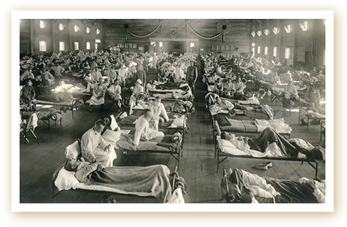 Spanish Flu Epidemic of 1918
Spanish Flu Epidemic of 1918
Cheaply made apartment buildings with very little living space, called tenements, were built in areas of the city that were uncared for and run down. Rapid growth and lack of planning led to inadequate basic facilities and services in large cities. Pollution and poor sanitation led to deadly epidemics in the towns and cities. Towns developed “good” sections and “bad” sections of town because people moved into neighborhoods they could afford. As cities grew, they expanded outward into more rural areas.
|
William M. Tweed - the "boss" of Tammany Hall, a Democratic Party political machine in 19th century New York City
|
There was a rise in crime because of the numbers of people who lived in poverty. Political machines preyed on the poor and newly arriving immigrants. They were dishonest politicians who worked to get their friends into government jobs based on bribery, corruption and unfair business practices. As living conditions in cities began to get worse, many Americans began to blame immigrants for the worsening conditions of cities. An idea called nativism gained popularity. Nativists believed the U.S. should stop allowing immigrants into the country to keep the conditions in American cities from getting worse. Anger over poor living conditions led to riots and strikes by residents in poor neighborhoods and factory workers.
|
The Positives
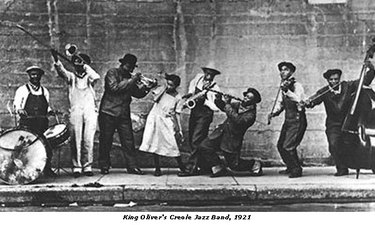
There were also positive results of urbanization. New public transportation systems developed to help cities manage large populations. Skyscrapers changed the way cities looked and were made possible by cheap steel and the invention of elevators. New infrastructure was created. Roads, bridges, tunnels, sewer systems, subway transits, electrical power stations, and many other types of infrastructure made city life easier. Cities offered many job opportunities for all kinds of people. Culture, entertainment, and recreation activities flourished in cities. Museums, libraries, public parks, amusement parks, movie theaters, and baseball parks were all positive additions to big cities. Immigrants and migrants created new American art forms. The most influential of these art forms was Jazz music.
WE'RE JUST GETTING STARTED
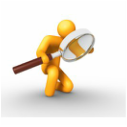
In this lesson, Topic 2 - U.S. Urbanization - you were introduced to urbanization. You learned what urbanization is and why it occurred. You were given an overview of the results that occurred because of urbanization as well. Each lesson of this topic will probe a little further into the major effects of urbanization - the good, the bad, and the ugly!
SMALL GROUP ACTIVITY
Growth Rates
In this activity, you will combine your math skills and social studies skills to gain a better understanding of the population growth that cities experienced during the late 1800s and early 1900s. Below you will see a worksheet with a chart of major U.S. cities and their populations in 1870, 1900, and 1920. As a group you will figure out the rate of growth for each city between 1870 and 1900 and 1900 and 1920, then answer the questions below the graph. To figure out the rate of growth, you will use the following formula and instructions.
STEP 1: Find the number of people that the population increased by, by subtracting the population in 1870 from the population in 1900.
STEP 4: Find the number of people that the population increased by, by subtracting the population in 1900 from the population in 1920.
Below I did Boston for you as an example.
The population increase from 1870 to 1900
The population increase from 1900 to 1920
STEP 1: Find the number of people that the population increased by, by subtracting the population in 1870 from the population in 1900.
- The Population in 1900 - The Population in 1870 = The number of people that the population increased
- The number of people that the population increased by ÷ The population in 1870 = The rate the population increased in decimal form.
- The rate the population increased in decimal form x 100 = The percentage that the population increased between 1870 and 1900.
STEP 4: Find the number of people that the population increased by, by subtracting the population in 1900 from the population in 1920.
- The Population in 1920 - The Population in 1900 = The number of people that the population increased
- The number of people that the population increased by ÷ The population in 1900 = The rate the population increased in decimal form.
- The rate the population increased in decimal form x 100 = The percentage that the population increased between 1900 and 1920.
Below I did Boston for you as an example.
The population increase from 1870 to 1900
- The population of Boston in 1870 = 250,525
- The population of Boston in 1900 = 560,892
- 560,892 - 250,525 = 310,367
- 310, 367 ÷ 250,525 = 1.24
- 1.24 x 100 = 124%
- The population increased by 124% from 1870 to 1900
The population increase from 1900 to 1920
- The population of Boston in 1900 = 560,892
- The population of Boston in 1920 = 748,060
- 748,060 - 560,892 = 187,168
- 187,168 ÷ 560,892 = 0.33
- 0.33 x 100 = 33%
- The population increased by 33% from 1900 to 1920
Remember to glue these into your Lesson Chronicles after we complete them.
If you are viewing this at home, make sure to scroll down this document. There are two pages.
INDIVIDUAL ACTIVITY
Answering the Essential Question

A Lesson Chronicles Activity is an individual activity where you prove that you accomplished the lesson mission. Lesson Chronicles require you to keep a notebook or journal with a table of contents. Each entry should be dated. First, you write the lesson mission. Then you prove you "can do" whatever the mission says by answering the essential question of the lesson in PQA format. Remember PQA format means "Put the Question in the Answer".
DIRECTIONS: Work by yourself to prove you have completed today's mission successfully by answering the essential question for today. Answer the question on the first page of your Lesson Chronicles under your Lesson Mission.
HOMEWORK
Finish the Lesson and Family Time
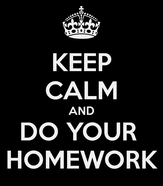
Remember, you have homework every night in Social Studies. Your homework is to show your Lesson Chronicles to your family and tell them what you learned today. Not only will this give you quality time with your family but it will help you review for your unit test. Go over your lesson chronicles entry from today everyday to help you study for the Topic Quiz and Unit Test.
If you did not complete any assignments from today, they are homework. You never know when I am going to check chronicles, so make sure you are keeping up!
If you did not complete any assignments from today, they are homework. You never know when I am going to check chronicles, so make sure you are keeping up!
END OF THE UNIT 3 TOPIC 2 MODULE
Resources Used in this Lesson
